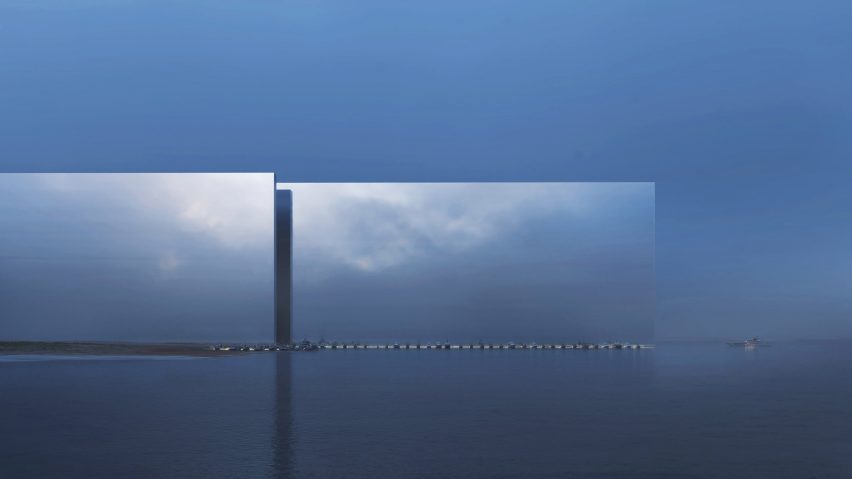
"Why would architects let themselves be so vitiated?"
A recent documentary about The Line mega-project in Saudi Arabia paints a bleak picture of the architecture profession, writes Dana Cuff.
I've often been frustrated that architects are sidelined in the delivery of much-needed new housing. We are left to compete for commissions with design results bound by a priori constraints. Wouldn't it open up far more and far better possibilities to involve architects – the most skilled in site planning, material and building technology, and housing design – from the beginning?
The Line promised to be just such an opportunity for architects to design the future, with innovative solutions for sustainability and housing for all. How did it go so drastically wrong?
The documentary shows The Line concept, along with our profession, diminished
Saudi Arabia has so much money that it's willing to try everything. Couple that with the fact that architects have so little money that they appear to be willing to do anything, and you have a recipe for The Line.
In a recent documentary, Saudi Arabian crown prince Mohammed bin Salman delivers an affable, in-your-living-room story hour, in which he parades no fewer than 25 architects and other experts to enthusiastically persuade viewers that the 170-kilometer-long futuristic development will create neighborhoods for everyone, will save the planet, and is the first real utopia since the 1964 Plug-In City by Archigram.
The documentary is simultaneously a portrait of The Line and the architectural profession. Its storyline is largely delivered by the architects working on The Line, led by Archigram founder Peter Cook and Morphosis principal Thom Mayne.
The cast is nearly all-male and all-white (of the 25 people featured, 14 men speak multiple times before the first of just five women appears). Call me a bean-counter rather than a poet – a disparaging distinction that Cook wields – but it's easy to see that any world-making by The Line will remain unchallenged from the point of view of privilege, race, youth, income, or gender. As Tom Ravenscroft noted in June, The Line is the vision of architects who are overwhelmingly pale, male and stale.
Completely missing from the narrative are any engineers, scientists, historians, economists or environmentalists – relegating architects to producing cinematic CGI set decoration without intellectual foundation. How, in current times, does a future city seem plausible, let alone provocative, without some very serious climate scientists and racially diverse leadership? Even if those consultants are behind-the-scenes, it would take some serious magic to transform the thin future currently envisioned into a robust social and sustainable proposition.
The documentary shows The Line concept, along with our profession, diminished. Why would architects let themselves be so vitiated? When all that Saudi money meets a profession growing increasingly poor by many measures, even the biggest reputations in the field are opportunists. What we see is a hostage video, where the Stockholm syndrome appears to have taken hold of the talking heads. Any discussion of the controversy surrounding the project, including reported death sentences for protestors which have prompted scorn from the UN, is conspicuously absent.
What this documentary presents as just some fun among the old guard might actually be architecture's kiss of death
A lot of architects in the major cities of America and Europe have been sucked into The Line, with the prospects of earnings, fame, and comradery. What this documentary presents as just some fun among the old guard might actually be architecture's kiss of death. Leave aside the design-washing as Bin Salman seeks to repair his reputation post-Khashoggi, or greenwashing of the kingdom's fossil-fuel earnings, and consider what architecture offers for the future at this particular historical moment.
The documentary is filled with yesterday's tomorrow, pictured in nostalgic 20th-century footage of the 1939 NY World's Fair where Norman Bel Geddes designed the Futurama exhibition with highways and skyscrapers pointing toward the future, and of a housewife planting a thankful kiss on her husband for giving her a new station wagon. A short clip of a girls' soccer team presents the only Black face in a stream of anachronistic imagery. For Neom, and by implication for the design profession, today's tomorrow is unburdened by the science of global warming or gender discrimination, race, class or poverty.
The future world they envision seems as dull and naive as other utopias in comparison to the fraught, complex, intricate real world it seeks to replace. The current reality lived by architects who can be held hostage for cash and a chance to deliver some heroic vision is bleak, but it's impossible to feel sorry for them. How radically optimistic is a very different, complex future where architects take responsibility for housing that is affordable, advancing equity, and reducing greenhouse gases? Where we confer with the wonks, the beancounters, and the poets, to listen, learn and exact our highest talents on behalf of a greater good.
In that world, race, gender, science, creativity and politics are all recognizable ingredients that will open the world we want to live in. Now that is the future we have to imagine.
Dana Cuff is director of cityLAB and a professor of architecture and urban design at the University of California, Los Angeles.
Dezeen In Depth
If you enjoy reading Dezeen's interviews, opinions and features, subscribe to Dezeen In Depth. Sent on the last Friday of each month, this newsletter provides a single place to read about the design and architecture stories behind the headlines.